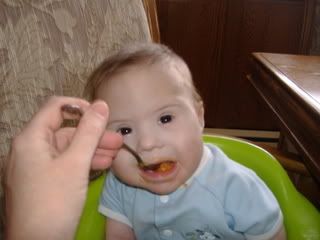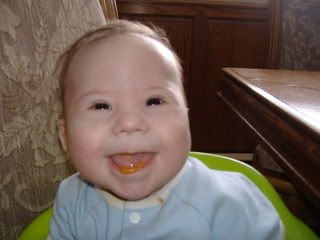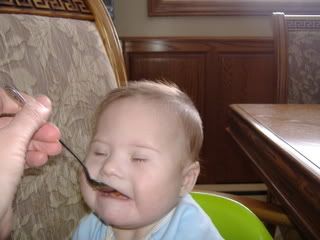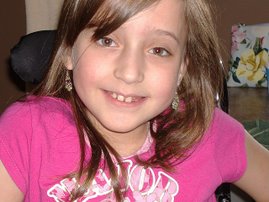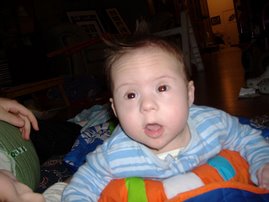People in general need many vitamins, minerals and antioxidants....proper carbs, good fats, good protein sources, fiber and pure water.
So when it comes to our children... I will say I know we can't "cure" them ...but I believe they can with the right stuff,,,they can be the best they can be....and have better immune systems.
Prior to Connor, I have taken 2 courses -to become a CNC and a RHN...plus I have read over 300 books and own them so the value of nutrition is not a question to me...if like long ago our foods contained what they used to it would be ok...but they don't and each year they have less and less nutrients in them.sadly:(
Since having Connor I have buried my brain into books and websites on nutrition with regards to things our children with trisomy 21 are very susceptible to ....this following article is one of the best, easiest to understand articles with references that i found.....so after reading it and many other things....i went through what other supplements have in them ...what our kids seem to need and whats in the Nutrivene d....products...seems like a great match for me...for Connor....I started him on them last week and all ready notice a difference with regards to his attention and focus so I'm happy so far. I also, took him to a naturalpath before starting him on the supplements to test via a computer system (therefore pain free) all areas of his body...thyroid, endocrine, allergies, food sensitivities, etc, etc...heart even..not to my surprize he was all ready showing weaknesses in all the areas our kids seem to be susceptible in...so now I'll keep him on these products and a few other things ...then test him again in a few months and see ....I'm confident knowing what i know that this will be of benefit to him.
~~~~~~~~~~~~~~~~~~~~~~~~
Here's an article I found....about nutrition...
Down's Syndrome: Inevitable mental disorder or treatable metabolic disorder?
Down syndrome is the commonest cause of mental retardation and it affects many families. I am sure that most people will know someone with Down syndrome. For many years it has been regarded as a syndrome in which mental retardation and poor health is inevitable. However, this need not necessarily be so I would like to present two cases to illustrate .
Danny
My first case concerns a young man called Danny. He is a 28 year old man who presented moderately retarded,
with limited speech and single word- or two-word sentences. He did not use any prepositions. He lived in a sheltered home facilities and worked in a sheltered workshop. We deal with a lot of behavioural and learning difficulties in our clinic, and it was on this basis that he was brought in to see me. He was very agitated and was inclined to be violent; he would kick and bite. He was also very aggressive and confrontational and he had crying fits and would sob. He had been on traditional medications such as Melleril, a henothiazine used in psychotic disorders and a very sedative drug, and on Valium another tranquilliser. He did not appear to have much benefit from these drugs.
He also suffered from sleep disturbances. He had to perform night-time rituals and they had to be done in the right order. Unless these were done, he would not go to bed. Consequently, he did not get to bed until at least 11:30 pm and sometimes 3:30 am. Thus he had variable waking times in the morning. He had also self-comforting rituals, often observed among disturbed children, such as rocking behaviours or swinging from side to side. He simply could not sit still.
Jo
The other case was a young man called Jo. He was a 25 year old and was born looking apparently normal. However, he had
gradually developed widely spaced teeth, flat feet, a small head and he vomited a lot as a baby. No doubt this was due to food sensitivities. He became developmentally delayed and later was profoundly mentally-retarded with a low IQ. He had uncontrollable tempers, he was hyperkinetic, restless, over-active and he too rocked a lot as self-comforting behaviour. He had occasional seizures. He was found to have an abnormal EEG (electroencephalogram) and other neurological
abnormalities.
Danny’s treatment
I treated Danny as I tend to treat many behaviourally disordered patients, given that we were dealing with a 28 year old man, who went out and was uncontrollable in terms of diet and nutrition when out. As far as possible we eliminated sugars,
preservatives and colours from his foods. We steered him onto whole foods, again as far as possible. There
are certain nutrients that are indicated in children with behaviour disorders. It would be difficult to mention them all as these apply to individuals with what Roger Williams would call “biochemical individuality”. Among these are vitamin B6 (pyridoxine), magnesium, zinc, and certain amino acids, particularly phenylalanine, glutamine and adenosine. I also use tissue salts and homoeopathic remedies (Bach flowers and strammonium & veratrum), aroma therapy oils, such as lavender oil, and herbs passion flower, hops and valerian to sleep. We also introduced, wherever possible, behavioural interventions in the
home situation. Over a 12 months period he gradually improved, although I did not then see him for a space
of 8 months. He re-appeared, this time with his mother and carer, in my surgery. She told me that he had now
no agitation, he was now calm and controlled. There was no shouting, fighting, or violence. He had ceased to be aggressive or
confrontational. There were no crying fits and other symptoms of what we call being ‘emotionally labile’.
His sleeping pattern improved. The next bit of information surprised me. Danny was seeing his older brother, whom he had not seen for some 18 months, and after a while his brother said to his mother: “Mum, what have you done? He is
different.” In addition, his vocabulary had increased and he had begun using prepositions So here we have a
man who had been operating at an intellectual level far below his potential for many years, who now had
learned to speak. Yet, he had not received remedial teaching. He was using prepositions that he had never
used before. He was communicating better and his function in his workplace improved and he was moved to a new position. I had not expected this to happen. I was rather excited to see the effects of a change in nutrition. Unfortunately, I
had not done a earlier EEG to compare the results, but I was convinced that his learning and brain functions
had improved.
Danny was a typical Down’s Syndrome case. Jo was a slightly different case. Jo’s treatment was a very
simple nutritional intervention, removing a single amino acid from his diet; phenylalanine. Jo was what
is called a phenylketonuric. A Guthrie test 1 at birth now detects phenylketonuria (PKU). This is
an inborn metabolic disorder caused by the absence or a deficiency of the enzyme, phenylalanine hydroxylase,
responsible for the conversion of phenylalanine (an amino acid) into tyrosine 2 . It is an autosomal genetic disorder. People can be carriers and only partially be affected. The incidence is 1 in 10-20,000 and fortunately is rarely seen in adults now. Accumulation of phenylalanine is toxic to the brain tissue. If undetected at birth the patient may among other
symptoms become mentally retarded. Treatment consists of a diet low in phenylalanine. It is important to
realise that PKU inhibits pathways of an important neurotransmitter, serotonin, and this affects behaviour and moods. It also interferes with the Gamma-aminobutyric acid (GABA) pathway. This amino acid has a neurotransmitter-like activity, is found in the brain (and other organs) and keeps a person calm. It is an inhibitory chemical substance which, if it is disturbed, will result in problems with aggression. It is important that phenylketonuria be detected at or near birth, for if left untreated loss of 5 IQ points for every 10 weeks delay in diagnosis will result in mental retardation. Little benefits from treatment may be expected after 3 years of age.
Phenylketonuria and Down’s syndrome therefore have similarity in that nutritional intervention can influence brain function.
Down’s syndrome Down’s syndrome is the commonest single cause of mental retardation, and is caused by complete or partial excess of chromosome 21 (trisomy 21). In 89-90 per cent of cases this is caused by nondysjunction, where chromosomes don’t separate properly during cell division. One cell line has 47 chromosomes (instead of
46), and this line replicates; the other, 45 chromosomes, and this cell line dies.
Rarely, Down’s syndrome may be inherited (6%) or resulting from nondysjunction later in cell division (Mosaicism - about 2%). There are quite a few predisposing factors for this to occur.
The incidence of Down’s syndrome increases with maternal age; that is the older the woman giving birth the greater the incidence. One in 600 births give rise to Down’s syndrome in women below the age of 30. The incidence increases to one in 40 births by women above 45 years of age. Recent research suggests that this is possibly due to oxidant damage to the ovaries, causing nondysjunction. Studies show that mothers who are 35 years old or younger at the time when they give birth to a Down syndrome child have five times the risk of developing dementia themselves. This indicates
increased oxidative damage in the body, as the link between oxidative damage and dementia is becoming increasingly apparent. It is interesting to note that antioxidant treatment has a well-established role in the prevention of dementia. Other risk factors include;
• infection prior to conception
• abdominal X-rays prior to conception
• OC (contraceptive pill) use within three months of conception
• coeliac disease in either parent
• diabetes; thyroid disease; Chronic fatigue syndrome;SLE in either parent
Many of these risk factors could also be operating via oxidative damage to the ovaries.
Genetic defects
A chromosome is a package of a multiple genes.
Chromosome 21 provides a genetic blueprint for various proteins, enzymes and other metabolic substances. Therefore, a duplication of this chromosome as in Down syndrome will result in the disturbance of numerous metabolic pathways, and an excess of some gene products.
In phenylketonuria, in comparison, there is a lack of a single enzyme which results in the disturbance in one pathway in particular, and so a single corrective factor is adequate.
Superoxide dismutase enzyme (SOD)
Chromosome 21 encodes for several enzymes as now known. Perhaps the most important of these is the copper-zinc dependent enzyme Superoxide Dismutase enzyme (SOD).
This enzyme functions in the body to protect cells from harmful singlet oxygen and hydroxyl radicals 3, which are produced during normal cellular metabolism. Under the influence of the enzyme, the hydroxyl radicals and singlet oxygen 4 are converted to hydrogen peroxide, a very reactive chemical. Under normal circumstances, the selenium-dependent enzyme, glutathione peroxidase, neutralises the hydrogen peroxide. However, in Down syndrome, there is an excess of SOD production and
thus an excess production of hydrogen peroxide and a deficiency of zinc.
The body tries to compensate for this by increasing the production of glutathione peoxidase with resultant deficiencies of glutathione and selenium. This imbalance in hydrogen peroxide, glutathione, selenium and zinc, may well be the
mechanism behind the oxidative damage and early aging and increased presenile dementia seen in Down’s syndrome.
Purine metabolism
Also encoded for on chromosome 21 are enzymes necessary for correct function of the purine metabolismpathway. Purines 5 are the nitrogenous end products in the digestion of certain proteins. An inability to metabolize and excrete purines may develop into gout. There is evidence that among Down’s syndrome patients there is an increased incidence of gout, which can then be treated by avoiding foods containing high levels of purines and encouraging a purine-free diet, and increasing levels of folic acid to inhibit excess synthesis of uric acid.
Interferon
Chromosome 21 also encodes for the alpha/betainterferon receptor.
Interferon is a natural cellular protein formed when cells are exposed to a virus. It induces the production of ‘translation inhibitory protein’ (TIP) in noninfected cells. TIP blocks translation of viral RNA, thus giving other cells protection against both the original and other viruses. Interferon is species specific meaning that interferon produced in one species of animals cannot
be used by others. It has been trialled in the treatment of such diseases as hepatitis and also in cancer. Interferon is an important component of the immune system. The genetic blueprint in Chromosome 21 for the receptor is found to be disturbed in cases of Down syndrome.
Receptor sites for interferon on leucocytes may interfere with maturation and lead to failure in immunological development. Down’s syndrome is recognised as having chronic and recurrent illness, and having 10 times the occurrence of leukaemia compared to the general population.
Amino acid metabolism
Another important enzyme which it has been discovered is encoded for in chromosome 21 is an enzyme involved in amino acid metabolism. Amino acids are the building blocks of proteins and hence affect the manufacture of various enzymes. The particular enzyme is Cystathionine beta synthetase(CBS), responsible for the production of
cysteine as follows:
(Homocysteine + Serine) —> Cystathionine
—>[CBS]—> Cysteine
+ alpha-
ketobutyrate
Cysteine is a nonessential amino acid, but nutritionally important since it spares the essential amino acid methionine
Cysteine is also important in that it is the precursor of taurine in the formation of coenzyme A from the vitamin pantothenic acid (B5). The result of this disturbance in CBS is that there is an increase in certain amino acids and a decrease in others. This has been confirmed in studies with Down’s syndrome, in which it has been found, that there are deficiencies in serine, methionine and taurine.
Physical characteristics of Down’s Syndrome
Characteristics are not always shown at birth as maternal metabolism tends to compensate. Typically they have slow growth, they are short with a small head and have dry skin. They show an abnormal face, with a flat back of the head (flat
occiput) and usually they have slit eyes (epicanthic folds), pinpoint, white or light yellow spots on the iris of the eye (Brushfields spots). They may show middle ear abnormalities and abnormal skin formation around the fingers often indicative of chromosomal anomalies (abnormal dermatoglyphics). They may also display abnormal dental growth.
Patterns of dysfunction Down syndrome patients are typically retarded with an average IQ of about 55 untreated.
Fortunately, this can be improved upon through nutrition and intensive learning and socialisation programmes.
Thyroid dysfunction is quite common among Down syndrome patients. There is a marked dysfunction of the immune system, and so they suffer recurrent illnesses. As mentioned, studies show that individuals with Down’s syndrome have ten times
the incidence of leukaemia.
Significantly, they have severe gut dysfunction, marked by frequent constipation.
They often lack the necessary digestive enzymes to absorb their food. They invariable have a lactose intolerance. They are typically emotionally labile, meaning they suffer from mood swings from extreme joy to friendliness, stubbornness
and aggression.
They have an increased incidence of diabetes. Down’s syndrome patients usually show signs of presenile dementia or Alzheimer’s disease, typically in their 40’s. Other signs of a metabolic disorders are increased incidence of gout
and hyperuricaemia or presence of high levels of uric acid in blood.
Other biochemical disturbances currently known As pointed out chromosome 21 encodes for various enzymes and amino acids, many of which are defective in Down syndrome. • The same chromosome 21 controls the behaviour of various amino acids, the building blocks of protein. Often we find a disturbance in the glutamine/glutamate pathways. Although these amino acids are normally produced in the body, in Down’s
syndrome patients they may be dysfunctional. Glutamate and glutamine are intimately involved in brain processes by converting toxic ammonia into harmless substances via the urea cycle to be excreted in the urine. By supplementing Down syndrome patients with glutamine or glutamic acid we may be able to supply the brain with energy and improve intellectual capacity.
• Similarly, a disturbance in the tryptophan metabolism may cause a decrease in available serotonin, an important neurotrans mitter affecting a person’s emotions.
• It is known that Down’s syndrome patients are low in insulin growth factor no 1 (IGF1). It is responsible for making growth hormones. During baby-hood the equivalent is insulin growth factor 2 (IGF2) which should become IGF1 in adulthood. The enzymes involved are zinc dependent and zinc supplementation has been shown in studies to normalise IGF1.
• Disturbance in the carbohydrate metabolism contributes to an increased incidence of diabetes among persons with Down’s syndrome.
• Closely related to this is a reduced levels of pyridoxine (B6) which affect protein, carbohydrate metabolism and production of serotonin from tryptophan.
• Vitamin B12 is found to be generally deficient, which may be due to problems of absorption involving absence of the intrinsic factor from the stomach, pH levels in the gut, or interference by other medical drugs.
Vitamin B12 and folic acid are essential in heme production, which form part of red blood cells. B12 is essential in the correct production of DNA, without which cells cannot mature.
• Digestive enzyme deficiencies are common among Down syndrome patients and this results in general malabsorption of nutrients. Of particular importance is lactose intolerance so milk products should be avoided. Antibodies have been
found to bile ducts (75%), parietal cells (62%), and smooth muscles.
• It is common to find thyroid dysfunction among Down syndrome patients. They usually have a small thyroid gland. Again auto antibodies are found to the thyroid. The consequence is that they under-produce thyroxine (T4), an important hor-
mone involved with the rate of metabolism, that will affect many bodily parameters such as temperature, metabolic rate, growth hormones, skeletal maturation, regulation of fat, protein and carbohydrate metabolism, synthesis of enzymes,
muscle tone. This explains why the skin tends to be dry, why they have a lot of constipation and problems with weight. It is interesting to note that among others thyroxine also stimulates the conversion of beta-carotene to vitamin A in the liver.
11 Zinc has been shown to normalise thyroid stimulating hormone (TSH) and T3 levels of thyroid function. • Vitamin B1 thiamine has been found to be particularly low. This vitamin is necessary for correct carbohydrate metabolism and for
nerve function.
Interhemispheric communication in the brain
Studies show that Down’s syndrome patients have a disturbance in their brain function, particularly in communication between one side of the brain and the other. This is something that is treatable. Patients seem to have a particular sensitivity to a drug called atropine (used for relaxing smooth muscles in the intestines and
other organs). This drug has the effect of blocking receptor sites for acetylcholine,a neurotransmitter mediating synaptic activity of the nervous system and muscles .
This disturbance of acetylcholine in the brain is of great interest.
As indicated earlier Down’s syndrome patients are prone to develop dementia. It has been found that they have difficulties binding aluminium, which has been implicated in the development of dementia. A study has shown a defective
gallium-transferrin binding in the brains of Down syndrome patients with Alzheimer’s disease. In Alzheimer’s patients this mechanism is thought to be involved in the accumulation of aluminium.
Management
It is important to realize that treating a Down syndrome child is treating a whole person, and not simply “pill taking”. We have to look at the social side of the illness, family support and behavioural management. There is a need for boundaries
of acceptable behaviour and discipline.
Specific features which need to be attended to are:
• Eyes/vision problems should be looked at by a developmental optometrist. 50 per- cent of Down’s syndrome children have eye and vision problems in the form of refractive errors, cataracts, keratoconus (noninflammatory protrusion of the
central part of the cornea), amblyopia (defective vision, approaching blindness, usually as a result of strabismus or the inability of both eyes to focus on the same object). They may need spectacles or to do eye exercises.
• Heart condition, which are usually picked up at birth. 30-60 percent of Down’s syndrome children have some form of cardiac condition.
• Together with structural abnormalities in the face, ears and hearing impairment is common. 65 percent of Down syndrome children have conductive hearing loss. It is important to correct hearing losses if we are dealing with learning disabilities and/or speech impediments.
• Orthopaedic problems are very common because of lax ligaments and poor muscle
tone. 10-20 percent of Down’s syndrome children have what is called an atlanto-axial instability, involving the atlas and axis of the vertebral column, and affecting the whole spinal part of the body, and related to this
• a lot can be done by regular exercise regimes promoting coordination, muscle tone and stimulation.
Nutrition
It goes without saying that we have to provide nutritional support to various parts of the body, to the thyroid gland, the digestive system, carbohydrate metabolism and so on. The earlier this regime is started the more beneficial it will be to
the child. If the condition is diagnosed early enough, the child does not need to develop Down’s syndrome, or does not have to develop mental retardation and an abnormal face. Treatment should include:
• Exclusion diets: diets should exclude food sensitivities which could be detected by a cytotoxic food testing, diets should exclude gluten in the case of coeliac disease, or milk products to avoid lactose intolerance, and
sugar, artificial colourings, flavours and preservatives.
• avoid aluminium cooking utensils
• Add green leafy vegetables, olive cooking oil, flaxseed oil on salad and vegetables, ginger, onion and garlic.
• Vitamin/mineral support is essential to maintain a proper carbohydrate metabolism. The B-complex vitamins and the minerals magnesium and chromium are an integral part of treatment.
Specific vitamins and minerals include:
1) Pyridoxine (B6) involved in protein metabolism and tryptophan conversion to serotonin,
2) folic acid for its methylation action together with vitamin B12, necessary for DNA synthesis,
3) zinc, a co-enzyme in many enzymatic processes in the body, important to the immune system, and to correct insulin factor-1 (IGF-1) abnormality.
• Thyroid support includes the checking of function ofthe thyroid gland at 6 monthly intervals. The diet should be supplemented with kelp, for its iodine source, and tyrosine and where necessary thyroxine. Adequate zinc levels are necessary.
• Amino acid correction can be implemented after a urinary amino acid profile.
The important amino acids supplements should include serine, methionine, glutamine/glutamate, tryptophan, taurine, tyrosine and others as indicated.
Studies have shown that a serotonin enhancing diet can decrease aggression by 95 per- cent.
Recent studies have shown that supplementation with L-carnitine produced significant improvement in mental status in Down syndrome patients, but not other categories of mental patients. 12
• Phosphatidyl- choline plus vitamin B5 will help the interspheric imbalance in the brain and promote neural transmission.
Lecithin is rich in choline and so is choline bitartrate obtainable in health food stores. Additionally, choline supplementation will improve sleeping abnormalities.
• Supplementation of antioxidantssuch as vitamins A, C, E, Beta-carotene and including minerals zinc, copper, manganese, selenium, glutathione (essential in the superoxide dismutase). This is to protect against the oxidant damage and im-
balance caused by the excess SOD enzyme and consequent deficiencies of zinc, selenium and glutathione.
Conclusion
A Californian paediatrician, Dr Jack Warner, has treated over 700 Down syndrome children in “the Warner House” following the principles outlined in this article.
They employed a team of experts in their fields such as a physical therapist, developmental optometrist and behavioural therapist and with their combined approach were able to produce Down syndrome children, able to attend normal schools.
This, of course, depended on the age at which children commenced treatment. Early treatment resulted in Down syndrome children having growth rates equivalent to normal, with an IQ in the normal range, general reduction in chronic illnesses and significantly, normalisation of facial features. There is a record of one child, age 5, obtaining an IQ score of 140!
Down syndrome stems from chromosomal defects resulting in abnormal cellular biochemistry. Some of these effects, at least, are reversible, others are preventable and others can be moderated.
Therefore, Down syndrome does not mean inevitable mental retardation: it is a metabolic disorder that can be treated to an extent that patients can function normally in society.
Clinical nutrition provides, indeed, a ray of hope!
Footnotes
1) In a Guthrie test a small amount of blood is obtained and placed in a medium with a strain of Bacillus subtilis, a bacterium that cannot grow without phenylalanine. It is a screening test for phenylketonuria used to detect the abnormal presence of phenylalanine metabolites in the blood.
2) Tyrosine is a forerunner of thyroxine, a hormone excreted by the thyroid gland which among other controls the metabolic rate.
3) Hydroxyl radicals - a particular reactive, damaging type of free radical, formed when superoxide radicals react with hydrogen peroxide. They are thought to be the damaging agent to joint membranes in arthritis.
4) Singlet oxygen is an activated energetic reactive form of oxygen which can damage important macromolecules such as DNA
5) Purines are also present in many medications and other substances such as caffeine, theophylline (an
alkaloid found in tea and related to caffeine, also used in some bronchodilators), diuretics and muscle relaxants. Foods high in purines are anchovies and sardines, sweetbread, liver, kidneys and other organ meats, legumes and poulrtry. Foods lowest in purine includes eggs, fruits, cheese, nuts, sugar, gelatin and vegetable other than legumes.
6) Formed from methionine, cysteine is easily transformed into usable cystine, together with methionine are major sulphur containing amino acids. It is a component of the glucose tolerance factor (with glycine, glutamic acid, niacin and chromium).
Cystine or cysteine are essential for utilization of B6.
Production of cysteine from methionine is prevented in chronic disease. Protects against effects of alcohol and smoking. Involved in hair strength. Involved in insulin production. Flexibility of skin through attack on free radicals.
7) Stryer,L(1988), Biochemistry,WH Freeman & Co NY,page 584
8) Methionine: An essential amino acid which among others control the overload of fat in your liver. Methionine’s sulphur content helps the liver to manufacture lecithin, a valuable fat-fighting substance. Methionine acts as an antioxidant, deactivating free radicals. It also ‘chelate’ or grab hold of metallic substances and heavy metals (lead, mercury & cadmium) that might otherwise cause toxicity. It is a methyl donator in B12 metabolism. Gives rise to taurine and cysteine and cystine. Detoxifies excess histamine (important in histadelic schizophrenia). Essential for selenium
bioavailability, an essential co-enzyme in glutathione peroxidase, which attacks free radicals.
9) Synthesised from methionine (or cysteine in liver), taurine helps to nourish brain cells. It works with choline to maintain neurotransmitters that promote thinking. It is often used as an addition in the treatment of epilepsy. Inhibited by estriadol. Helps overcome obstruction in the flow of bile (cholestasis). Taurine in serum rises with low zinc serum , and
results in low taurine levels in the brain,thereby increasing the chances of ‘fits’.
10) Serine - A nonessential amino acid (meaning the body can synthesise it) found in many proteins in the
body. It is also the precursor of glycine, which in turn is involved with porphyrins and heme proteins.
11) Nutrition Search Inc (1979), Nutrition almanac, 14
12) Carnitine is synthesised in the liver from lysine and methionine, vitamin C being essential for its conversion. Has a major role in transferring fatty acids into cells where they are used as energy sources.
By Dr Robyn Cosford The Hypoglycemic Health Association vol 12 number sept 1996
THE HYPOGLYCEMIC HEALTH ASSOCIATION, P.O. BOX 8,
SYLVANIA SOUTHGATE, N.S.W. 2224
Page 7
The Hypoglycemic Health Newsletter
- 7 -
September, 1996 Vol. 12, No. 3
Further reading on Down’s Syndrome by Dr R Cosford:
1) Abalan F et al., A study of digestive absorption in four cases of Down’s syndrome, Med Hypothesis (UK)
31(1): 35-38, 1990
2) Airaksinen EM, Tryptophan treatment of infants with Down’s syndrome, Ann Clin Res 6(1); 33-9; Feb 1994
3) Anneren G et al., Growth retardation in Down’s syndrome in relation to insulin-like growth factors
and growth hormone, Am J Med Genet (suppl): 59-62, 1990
4) Antila E et al., Selenium therapy in Down’s syndroem (DS): a theory and a clinical trial, Adv Exp
Med Biol, 264: 183-6, 1990
5) Bennett FC et al., Vitamin and mineral supplementation in Down’s syndrome, Paediatrics 72(5),
707-13, Nov 1983
6) Bidder RT et al., The effects of multivitamins and minerals on children with Down’s syndrome, Dev Med
Child Neurol 31(4): 532- 7, Aug 1989
7) Brugge KL et al., The role of alterations in free radical metabolism in mediating cognitive impairment
in Down’s syndrome, EXS: 1992;62: 190-8
8) Cantor DS et al., A report on phosphatidylcholine therapy in a Down’s Syndrome child, Psychol Rep 58(1): 207- 17, Feb 1986
9) Chiricob M et al., Enhanced DNA repair in lymphocytes of Down’s Syndrome patients: the influence
of zinc nutritional supplementation, Mutant Res On aging Genet Instab Aging (Netherlands) 295(3):
105-111, 1993
10) Coleman M et al., A double blind study of vitamin B6 in Down’s Syndrome infants, Part 1(197) Clinical
and biochemical results, J Ment Defic Res 29(Pt3): 233-40, Sep 1985
11) Editorial: Tryptophan and serotonin in Down’s Syndrome, Lancet 2(7896): 1554, 28 Dec 1974
12) Farrar et al., Defective gallium - transferrin binding in Alzheimer’s disease and Down’s syndrome:
possible mechanism for accumulation of aluminium in brain, Lancet 1990: Mar 31; 335(8692): 747-50
13) Gedye A, Serotonergic treatment for aggression in a Down’s syndrome adult showing signs of Alzheimer’s
disease, J Ment Defic Res 1991: June: 35(Pt3): 247-58
14) Grener Y et al., Molecular structure and expression of the gene locus on chromosome 21 encoding the Cu/Zn superoxide dismutase and its relevance to Down’s Syndrome, Ann NY Acad Sci 450: 133-56, 1985
15) Hestnes A et al., Cystathionuria in Down’s Syndrome, J Ment Defic Res 33(Pt 3); 261- 5, June 1989
16) Justice PM et al., Micronutrients status of children with Down’s Syndrome: A comparative study of the effects of megadoses of vitamins with minerals or placebo, Nutr Res (USA) 8(11): 1251-58, 1988
17) Kleijnen J et al., Niacin and vitamin B6 in mental functioning: A review of controlled trials in humans, Biolog Psychiatry (USA) 29(9): 931-41, 1991
18) La Perchia P, Behavioural disorders, learning disabilities and megavitamin therapy, Adolescence Fall
22 (87): 729-38, 1987
19) Lejeune J, Pathogenesis of metal impairment in trisomy 21, Ann Gent 1991; 34(2): 55-64
20) Lejeune J et al., Homocysteine and methotrexate toxicity in trisomy 21, Cancer -
Chemotherapy - Pharmacology 1991; 27(4): 331-2
21) Lejeune, J et al., Amino acids and trisomy 21, Ann Genet 1992: 35(1): 8-13
22) Licastro F, Zinc affects the metabolism of thyroid hormones in children with Down’s syndrome:
normalisation of thyroid stimulating hormone and reversal of tri-iodothyronine plasmic levels by
dietary zinc, Int J Neurose, 1992 Jul-Aug; 65(1-4): 259-68
23) Lockitch G et al., Infection and immunity in Down’s Syndrome: a trial of long term low oral doses
of zinc, J Paediatr 114(5): 781-7, May 1981, Comment in: J Paediatr 116(3): 487-8; Nov 1990
24) Menolascino FJ et al., Vitamin supplements and purported learning enhancement in mentally retarded
children, J Nutr Sci Vitaminol (Tokyo) 35(3): 181-92, June 1989
25) Napolitano G et al., Growth delay in Down’s Syndrome and zinc sulphate supplementation, Ann J Med
Genet 7 (Suppl): 63-5, 1990
26) Napolitano G et al., Is zinc deficiency a cause of subclinical hypothyroidism in Down’s Syndrome?, Ann
Genet (France) 33(1): 9-15, 1990
27) Neve J et al., Selenium and glutathione peroxidase in plasma and erythrocytes of Down’s Syndrome (trisomy 21) patients, J Ment Defic Res (England) 28(4): 261-268, 1984
28) Palmer S, Influence of vitamin A nutriture on the triamine response: findings in children with Down’s
Syndrome,
29) Peeters MA et al., Excessive glutamine sensitivity in Alzheimer’s disease and Down’s syndrome
lymphocytes, J Neur Sci 1995 Nov: 133(1-2): 31-41
30) Peeters MA et al., In vivo folic acid supplementation partially corrects in vitro methotrexate toxicity in patients with Down’s syndrome, Br J Haematol 1995, Mar; 89(3):678-80
31) Peeters MA et al., Metabolic anomalies in trisomy 21: a method for analysing lymphocyte cultures, Bull Acad Natl Med 1994 Nov; 178(8); 1521-32
32) Peeters, MA et al., Differences in purine metabolism in patients with Down’s syndrome, J Intell Disab Res 1993 Dec; 37(Pt 6): 491-505
33) Pueschel SM et al., 5-hydroxy tryptophan and pyridoxine, their effects in young children with
Down’s Syndrome, Ann J Dis Child 134(9): 838-44, Sep 1980
If you got all the way through this copy , paste and print it out...compare it to what you are currently giving your child...see if he/she is getting all that is suggested as being beneficial if not essential.
I hope this helps you with your search for answers...Good Luck...what a challenge...so I'm finding. Good thing I like a good challenge.
